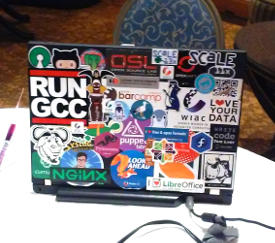Larry the BSD Guy
My laptop cover always gets looks wherever I set up to work — usually at Firefly Coffee House in Santa Cruz, where once a five-year-old stared at my cover for literally three minutes. I timed him. But yesterday, I was at Aptos Coffee Roasting Company, not far from Cabrillo College, where I hunkered down while waiting for my daughter to finish her Japanese class (sorry, Firefly — but in my feeble defense, you are not open past six).
A father and son sat at a table nearby, laptops open and I assume they were working on things individually. At one point, the father got up and approached me.
“Is that Run GCC, like Run DMC?” He asked about one of the more prevalent stickers on the cover of my ThinkPad T500. We laughed about it, we introduced ourselves — his name is Roger and he’s a Java developer — and we started a conversation about what we were working on.

And for the first time in just over nine years, I had a different answer than the one I normally give: “No. On this, it’s PC-BSD.”
Roger was surprised. As a FreeBSD user on a server at home, he was surprised that I — or anyone else, for that matter — would run BSD for day-to-day use on a laptop. But here I am doing that, and I had a chance to let him know about the short time, so far, that I’ve been using PC-BSD.
Allow me to relate to you today what I told him yesterday: It’s a little different going from Linux to BSD, the learning curve is not very steep for those who are regular Linux users, one gets used to it quickly, and best of all is that there is a noticeable performance uptick in the hardware. I’m no Michael Larabel and I don’t have Phoronix’s array of equipment to do benchmarks, but the improved performance is something one can easily see when doing everyday work.
Linux was fast enough on this machine. But in street racing parlance, with PC-BSD I’m burning rubber in all four gears.
I showed him the Xfce desktop, which essentially makes it indistinguishable from Linux (and with the exception of not having the Xfce Elementary Dark icon set, it looks just like my former Korora setup). The AppCafe allows one to easily obtain software, which led to a Emacs vs. Vim discussion — we both prefer Vim — and the son incidentally was working on something in Vim when I went over to introduce myself. A wide variety of FOSS programs are available and run flawlessly on PC-BSD, just as they do on Linux.
That said, despite a few things I have to try to sort out — for example, it appears that the font in Firefox is something I can’t change (or it’s not completely obvious) and the fact that I’m trying to find a quiet mode for the GRUB startup because, well, the startup is somewhat intimidating — I get to paraphrase Rick Blaine at the end of “Casablanca” when describing my current daily setup: “PC-BSD, I believe this is the start of a beautiful friendship.”





Cool! I live and work outside of Philadelphia, and it’s exceedingly rare for me to run into anyone that has a laptop running anything other than Windows, OS X, or Chrome OS.
I use XFCE everywhere because in my experience it’s the most consistently stable desktop environment. I just wish it was a little prettier. Even with some font changes and the Elementary Dark icon set, when I park it next to my colleagues with their Macbook Pro laptops with greater than 1920×1080 display resolution, I’m clearly the one with the ugly duckling. I don’t like using the graphical interface of OS X, but I have to admit it’s downright stunning to see on ultra high resolution displays.
KDE5 is as pretty as OS X or close, but every time I used it so far it’s been so crash-happy I gave up.
GNOME 3 is right behind KDE5 and in my experience totally stable, but I have traditional taskbars and program menus in my muscle memory so the GNOME 3 and even GNOME 3 classic interface seem totally alien even after weeks of trying them.
For those moments when you feel like the other OS is prettier, I always resort to how much it cost you? Same work done less $$$ spent.
That always cheers me up.
Greetings from Monterey County! Thanks for sharing the names of those coffee places. I’m always looking to try different coffee spots.
Happy Holidays!
So basically what you’re saying is that when you put a bunch of GNU software on top of something other than Linux, you can’t tell the difference. Hasn’t that basically been the GNU Project’s argument for GNU being the primary part of the operating system for the last few decades? People never seem to understand just how little difference Linux makes to a system versus GNU.
I may question your reasons for switching, but I think that someone covering BSD is overdue.I hope you go more into the differences in your next few posts.
You should try open solaris sometime.
“So basically what you’re saying is that when you put a bunch of GNU software on top of something other than Linux, you can’t tell the difference. Hasn’t that basically been the GNU Project’s argument for GNU being the primary part of the operating system for the last few decades? People never seem to understand just how little difference Linux makes to a system versus GNU.”
BSD does not use GNU as it’s userland man…
“BSD does not use GNU as it’s userland man…”
You’re right, but it does use many, many, pieces of GNU software, like GCC (in the article), and while GNU’s GNOME is the default in many flavors of BSD, Xfce (in the article) uses GNU’s GTK+. BSD by itself resembles “Linux” far less, when you add a bunch of GNU software it starts to look more and more like “Linux”… so, why do we call it “Linux” when what makes it “Linux” is GNU?
>> “You’re right, but it does use many, many, pieces of GNU software, like GCC (in the article), and while GNU’s GNOME is the default in many flavors of BSD”
That’s not accurate anymore. FreeBSD and PC-BSD use the Clang compiler, not GCC. in fact, FreeBSD has tried to remove virtually all GNU software from the lower levels of the OS.
The only version of BSD that uses GNOME as the primary desktop is GhostBSD (actually, they use MATE, but that’s close enough). As for GTK+, yes that is a GNU library, but it is one small piece in the overall OS. Basically, there is very little GNU software involved where PC-BSD running Xfce is concerned.
Quote: “I just wish it was a little prettier.” Xfce can be prettier, even prettier than other pretty desktops. You just need to be creative, artistic and resourceful. If only I can post my screenshots here, I would. On the OS part, I still prefer a rolling Linux distribution, always up-to-date, without compromising stability, and has tons of packages, without adding too many repositories. And that’s Manjaro Linux Xfce.
Ben and Guruguru,
gtk, gtk+, gimp and gnome… all of them are not gnu projects despite the initial “g”. 🙂
Is there a PC-BSD live distro to recommend?
@Ben, To be clear, NO version of BSD uses GNOME. It must be installed, if you want to use that, just like everything else outside the core operating system. GhostBSD and PC-BSD are FreeBSD with all those additional things installed; similar to a Linux “distro” (but please don’t call it a distro).
Quote: “As for GTK+, yes that is a GNU library, but it is one small piece in the overall OS.”
Not to mention that PC-BSD is working on Lumina desktop, which uses QT. I use that now daily, and very rarely use GTK apps.
@Ben Wow, I had no idea to what extent the BSD folks were doing away with GNU software in their system(s). My point does still stand though, when you do add GNU software to BSD it becomes more “Linux”. GTK+ is a small piece of software, but that one small library makes the much larger Xfce desktop environment possible. While I would argue that changing out Linux with one of the BSD kernels wouldn’t change a thing for most non-developer-type users.
XFCE isn’t even the default environment in PC-BSD and they are making their own desktop environment called Lumina, which I use. I struggle to think of one GTK app I use. In other words, there is barely any GNU.
@ReD No, each of those projects are developed by the GNU Project. Normally when a program has “GNU” in its name, that does mean it’s developed by or for the GNU Project. About the only project I know of that is an exception to this rule is GnuTLS, but it too was once a GNU project, it just eventually split from GNU.
I think there’s a misconception about what “being part of the GNU Project” actually means. It doesn’t mean RMS had anything to do with it, it doesn’t mean that the GNU Project funds the developer of the software, or anything like that. Most times it just means the GNU Project or the FSF owns the copyright to the program, that the code follows the GNU Coding Standards, or generally that the developers write and maintain the software specifically for inclusion into the GNU Operating System. In the case of GNOME, it is the official desktop environment for GNU. GIMP is similarly developed as a replacement to Photoshop for GNU. GTK+ and GLib are developed to make writing software for GNU easier.
They are all GNU software.
My limited experience with BSD is that, like MS, it sets the HW clock to local time. No choice. This is nuts. I think there’s a long-standing bug for it. All OSes seem to assume they are the only OS on a box. This is not valid. I have a working OS & an area to test new OSes. Linux sets the HWclock to UTC. Slack gives me a choice. I reject BSD because IMHO it does not play well with others. Sorry.
This is a silly reason not to try an OS. FreeBSD installer has option to set UTC and has done for as long as I remember. Respect for using Slackware though.
So glad to see that someone mentioned Lumina. As it was being developed when i last briefly tried bsd. As a Seventh Day Adventist i have the most disturbing part of bsd to be their mascot. A cutesy devil cartoon character just doesnt help me choose their design.
I hear mention that everything runs faster with bsd under the hood. Is that right? I had a similar experience switching from debian to arch (antergos). I wonder Mr Larry, if you’d compare and contrast an arch based linux system vs a bsd system as far as features and performance in some objective article as opposed to off the hand subjective rhetoric regarding how awesome bsd is.
Finally, it is still a good thing to have someone cover bsd because i dont think enough people hear about it. They dont have a Google or a Canonical backing them up financially and lets face it, Apple hasnt done anything to improve the face of bsd whose code base they use(d).
I might give BSD another spin just to see how lumina is progressing if nothing else. I have a few older machines now that might be more compatible with bsd out of the box to make installing and configuring it a reasonably painless process.
Several comments mention GNOME and GTK+ as GNU software – and at least one mentions QT as an alternative. Well, QT and KDE are also GNU software to the extent that they’re licensed under the GPL. Not sure what you mean by GNU – other than the political argument that the FSF ‘owns’ the right to include ‘GNU’ in the name of all software that uses GNU tools. And that’s okay too, I guess. Just odd to see GNOME being used to ‘define’ a GNU system – and used in reference to an article about how PC-BSD looks just like Linux…
Thanks for putting me straight littlenoddles. I’ve got to admit my ignorance over FSF and GNU. I should’ve educated myself before making statements such as “there is barely any GNU” software on BSD.
And you’re right that it is all just semantics. But why I felt the need to speak out, is that someone is implying on a technicality that PC-BSD offers nothing new that you wouldn’t find in a typical Linux distro. But a PC-BSD system has its own unique feel. Just for example, it makes use of boot environments to do safe updates and can rollback files individually through Lifesaver app or Lumina filemanager.
Sure this kind of stuff has been done before in e.g., Solaris, and I know OpenSUSE has its own attempt at boot environments, but PC-BSD is working hard to showcase technologies such as ZFS and jails in an interface that the average user is familiar with. People should try it out before assuming it won’t introduce them to anything new.
A list of GNU packages.
https://en.wikipedia.org/wiki/List_of_GNU_packages
@SarcasticFringehead, you should learn more about a subject before ranting about it. The PC-BSD design decision to _default_ to local-time is a very reasonable approach for an OS that is intended to simplify matters for more novice users. (FreeBSD gives you a choice.) … And, it darn well is “valid” if one is new to alternative OS’s and is going to be dual-booting with an M$ system. Which is the whole point: a newbie doesn’t want to see their time change every time they change OS’s and not know why. Anyone else should know (or be able to quickly find out) that this is an easily changed configuration setting.
I disagree that defaulting to local time is ever a reasonable choice.
Copying Microsoft’s moronic decisions isn’t doing anyone any favors.
@littlenoodles Oh my gah~ That is the worst, dumbest understanding I have ever seen of what GNU software is, and the overwhelming majority of Linux/BSD users make that fundamentally flawed assumption. Being GNU software has ABSOLUTELY NOTHING TO DO WITH USING THE GPL. The GNU Project prefers its own license, of course, but using the GPL is not a requirement for being a GNU package, and using it definitely doesn’t automatically make the software part of the GNU Project. There are strict requirements to be met before the GNU Project recognizes it as GNU software, GTK+, GNOME, GIMP, etc., all willingly follow these rules.
You can see all the GNU software here: http://www.gnu.org/software/software.html (GTK+, GNOME, GIMP are listed)
And what is required to be considered GNU software here: http://www.gnu.org/help/evaluation.html
I use GNOME as a definition of a GNU system simply because IT IS the GNU Operating System’s graphical user interface. It just happens to commonly be used with Linux, or BSD, etc. GNOME and GTK+ (Xfce) should be seen as GNU traits, not Linux traits. The same is true of the many system tools a given system may also choose to use by default or pull in as dependencies.
My original point is about how when people add more GNU software to any given system, it somehow becomes more “Linux-y”, despite not using Linux. That has been a long standing argument by the FSF for calling Linux distributions “GNU/Linux” or otherwise asking for credit where it’s due. Because many of the most defining aspects of “Linux” are actually GNU.
I am not a big fan of ZFS – too much memory overhead. Also there is no build for Rstudio with any *BSD. Also you still cannot secure boot with an *BSD. Wireless support is till spotty. Thus I prefer running Windows 10 with VMware and run OpenBSD is a VM or run Ubuntu as a host with OpenBSD as a VM. Theo is a genius, I have no doubt, and OpenBSD needs your support.